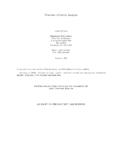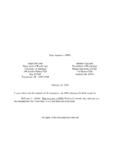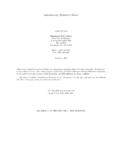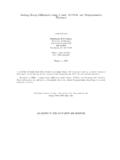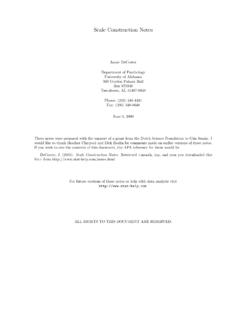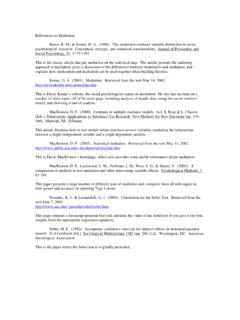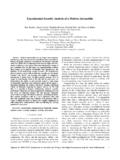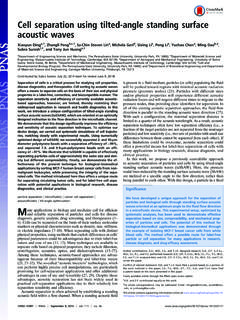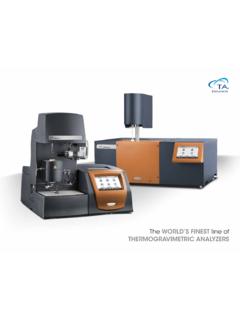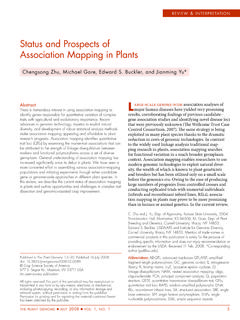Transcription of Meta-Analysis Notes - Stat-Help.com
1 Meta-Analysis NotesJamie DeCosterDepartment of PsychologyUniversity of Alabama348 Gordon Palmer HallBox 870348 Tuscaloosa, AL 35487-0348 Phone: (205) 348-4431 Fax: (205) 348-8648 September 19, 2004 These were compiled by Jamie DeCoster, partially from a course in Meta-Analysis taught by Alice Eagly atNorthwestern University. Handbook references refer to Cooper & Hedges (eds.),The Handbook of ResearchSynthesis. If you wish to cite the contents of this document, the APA reference for them would beDeCoster, J. (2004). Meta-Analysis <month, day, and year you downloaded this file>from future versions of these Notes or for help with data analysis RIGHTS TO THIS DOCUMENT ARE Introduction and Overview22 Formulating a Research Problem53 Searching the Literature74 Coding Studies105 Calculating Mean Difference Effect Sizes156 Calculating Correlation Effect Sizes257 Issues in Calculating Effect Sizes298 Describing Effect Size Distributions329 Examining Moderating Variables3710 Writing Meta-Analytic Reports4211 Critically Evaluating a Meta-Analysis461 Chapter 1 Introduction and Basics Definition of Meta-Analysis (from Glass, 1976):The statistical analysis of a large collection of analysisresults for the purpose of integrating the findings.
2 The basic purpose of Meta-Analysis is to provide the same methodological rigor to a literature reviewthat we require from experimental research. We refer to the direct investigation of human or animal data as primary research. Providing a reportof primary research using statistical methodology and analysis is called quantitative synthesis or Meta-Analysis . A report of primary research using traditional, literary methods is called a narrativereview. Meta-analyses are generally centered on the relationship between one explanatory and one responsevariable. This relationship, the effect of X on Y, defines the analysis . Meta-Analysis provides an opportunity forshared subjectivityin reviews, rather than true of meta-analyses must sometimes make decisions based on their own judgment, such as whendefining the boundaries of the analysis or deciding exactly how to code moderator variables.
3 However, Meta-Analysis requires that these decisions are made public so they are open to criticism from otherscholars. Meta-analyses are most easily performed with the assistance of computer databases (Microsoft Access,Paradox) and statistical software (DSTAT, SAS). Criticisms of Narrative Reviews The sample of studies examined in a narrative review is based on the author s whim, rather than onpublicly shared standards. Narrative reviews rely on statistical significance for evaluating and comparing studies. Significanceis dependent on sample size so a weak effect can be made to look stronger simply but adding moreparticipants. Narrative reviews lack acceptable rules of inference for going from the findings of studies to overallgeneralizations about the research literature. Narrative reviews are not well-suited for analyzing the impact of moderating variables. Authors ofnarrative reviews rarely reach clear conclusions regarding how methodological variations influence thestrength of an effect.
4 They also typically fail to report the rules they use to classify studies whenlooking for the effect of a moderating Many research literatures have grown too large to for a human to accurately synthesize without theaid of statistical Types of meta-analyses By far the most common use of Meta-Analysis has been inquantitative literature reviews. These arereview articles where the authors select a research finding or effect that has been investigated inprimary research under a large number of different circumstances. They then use Meta-Analysis tohelp them describe the overall strength of the effect, and under what circumstances it is stronger andweaker. Recently, as knowledge of meta-analytic techniques has become more widespread, researchers havebegun to usemeta-analytic summarieswithin primary research papers. In this case, meta-analysisis used to provide information supporting a specific theoretical statement, usually about the overallstrength or consistency of a relationship within the studies being conducted.
5 As might be expected,calculating a meta-analytic summary is typically a much simpler procedure than performing a fullquantitative literature Steps to Perform a the theoretical relationship of the population of studies that provide data on the the studies and compute effect the distribution of effect sizes and analyze the impact of moderating and report the Criticisms of Meta-Analyses (and Responses) Meta-Analysis adds together apples and purpose of a literature review is to generalize overthe differences in primary research. Overgeneralization can occur just as easily in narrative reviews asit can in Meta-Analysis . Meta-Analysis ignores qualitative differences between does not ignore these dif-ferences, but rather codes them as moderating variables. That way their influence can be empiricallytested. Meta-Analysis is a garbage-in, garbage-out is true. However, since the specific contentof meta-analyses is always presented, it should be easier to detect poor meta-analyses than it wouldbe to detect poor narrative reviews.
6 Meta-Analysis ignores study effect of study quality is typically coded as a moderator, sowe can see if there is any difference between good and bad studies. If a difference does exist, low qualitystudies can be removed from analysis . Meta-Analysis cannot draw valid conclusions because only significant findings are are actually less affected by this bias than narrative reviews, since a good meta-analysisactively seeks unpublished findings. Narrative reviews are rarely based on an exhaustive search of theliterature. Meta-Analysis only deals with main effect of interactions are examined through Meta-Analysis is regarded as objective by its proponents but really is relies onshared subjectivity rather than objectivity. While every analysis requires certain subjective decisions,these are always stated explicitly so that they are open to 2 Formulating a Research Defining the Research Question There are several things you should consider when selecting a hypothesis for should be a significant available literature, and it should be in a quantifiable hypothesis should not require the analysis of an overwhelming number of topic should be interesting to should be some specific knowledge to be gained from the analysis .
7 Some reasons to performmeta-analyses are to Establish the presence of an effect. Determine the magnitude of an effect. Resolve differences in a literature. Determine important moderators of an effect. When performing a meta-analytic summary you often limit your interest to establishing the presence ofan effect and estimating its size. However, quantitative literature reviews should generally go beyondthis and determine the what study characteristics moderate the strength of the effect. The first step to defining your research question is to decide what theoretical constructs you will useas your explanatory and response variables. You need to decide what type of effect size you will use. If the explanatory variable is typicallypresented as a categorical variable, you should probably used. If the explanatory variable is typicallypresented as a continuous variable, you should probably user.
8 If you decide to use the effect sized, you then need to precisely define what contrast you will use tocalculated. For a simple design, this will probably be (mean of experimental group - mean of controlgroup). Defining the contrast also specifies the directionality of your effect size ( , the meaning ofthe sign). The directionality is automatically determined for the effect sizeronce you choose Limiting the Phenomenon of Interest Once you have determined what effect you want to examine, you must determine the population inwhich you want to examine it. If you are performing a meta-analytic summary you will often chosevery practical boundaries for your population, such as the experiments reported in a specific populations for quantitative literature reviews, however, should be defined on a more abstract,theoretical level. In the latter case you define a specific set of inclusion and exclusion criteria thatstudies must meet to be included in the The goal of this stage is to define a population that is a reasonable target for synthesis.
9 You wantyour limits narrow enough so that the included studies are all examining the same basic phenomenon,but broad enough so that there is something to be gained by the synthesis that could not easily beobtained by looking at an individual study. The first criterion you must have is that the studies need to measure both the explanatory and responsevariables defining your effect and provide an estimate of their relationship. Without this informationthere is nothing you can do with a study meta-analytically. Each additional criterion that you use to define the population of your Meta-Analysis should be writtendown. Where possible, you should provide examples of studies that are included or excluded by thecriterion to help clarify the rule. You should expect that your list of inclusion and exclusion criteria will change during the course ofyour analysis . Your perception of the literature will be better informed as you become more involvedin the synthesis, and you may discover that your initial criteria either cut out parts of the literaturethat you want to include, or else are not strict enough to exclude certain studies that you think arefundamentally different from those you wish to analyze.
10 You should feel free to revise your criteriawhenever you feel it is necessary, but if you do so after you ve started coding you must rememberrecheck studies you ve already completed. It is a good practice to keep a list of the studies that turned up in your initial search but that youlater decided to exclude from your analysis . You should also record exactly what criterion they failedto meet, so that if you later decide to relax a particular criterion you know exactly what studies youwill need to re-examine, saving you from having to perform an entirely new literature 3 Searching the Basic Search Strategy Once you determine the boundaries of your Meta-Analysis , you need to locate all of the studies thatfit within those bounds. When performing a meta-analytic summary you will sometimes know at thestart exactly what studies you want to include. For other summaries, and for all quantitative literaturereviews, you will need to perform a detailed search to locate all the studies that have examined theeffect of interest within the population you defined.
